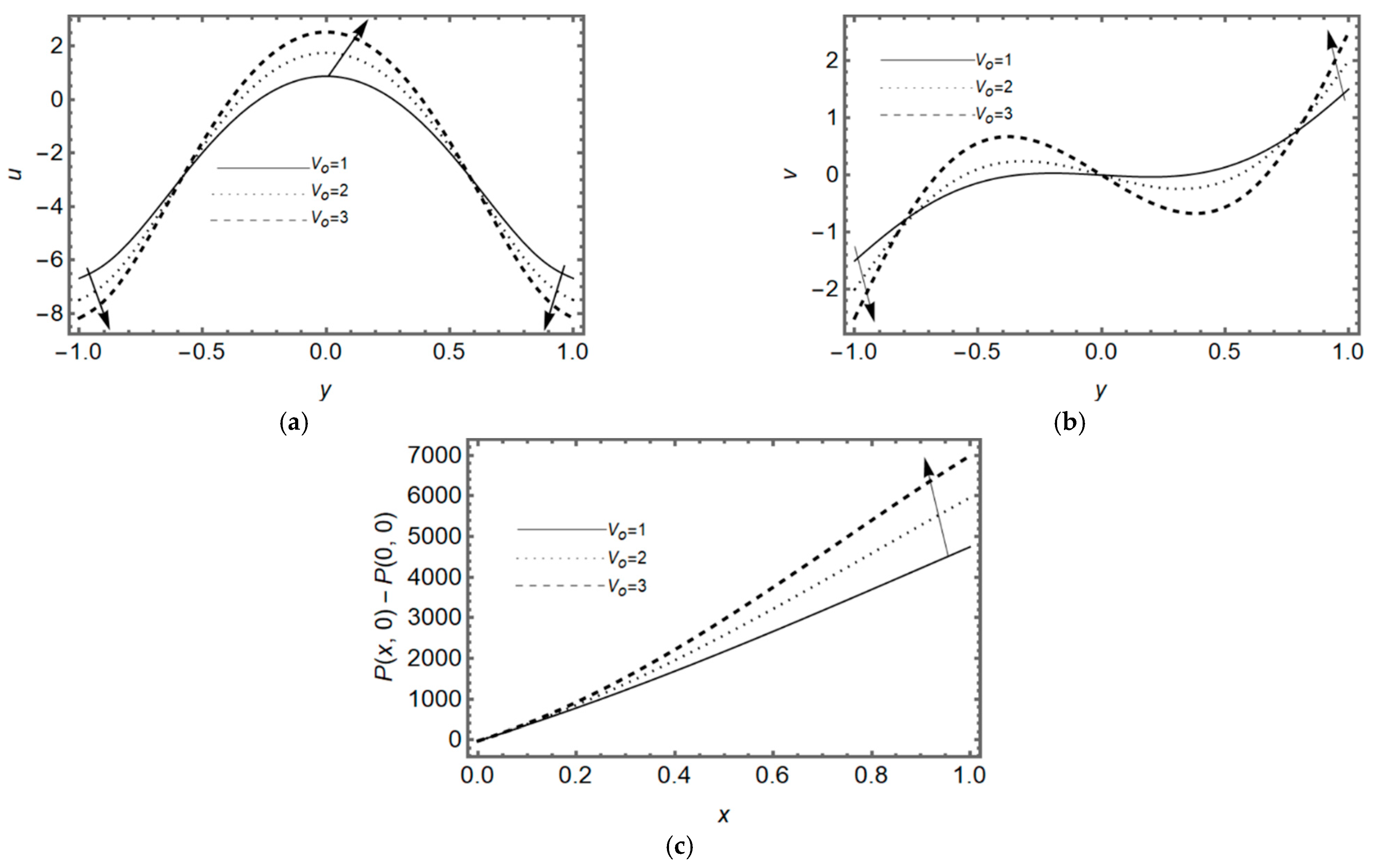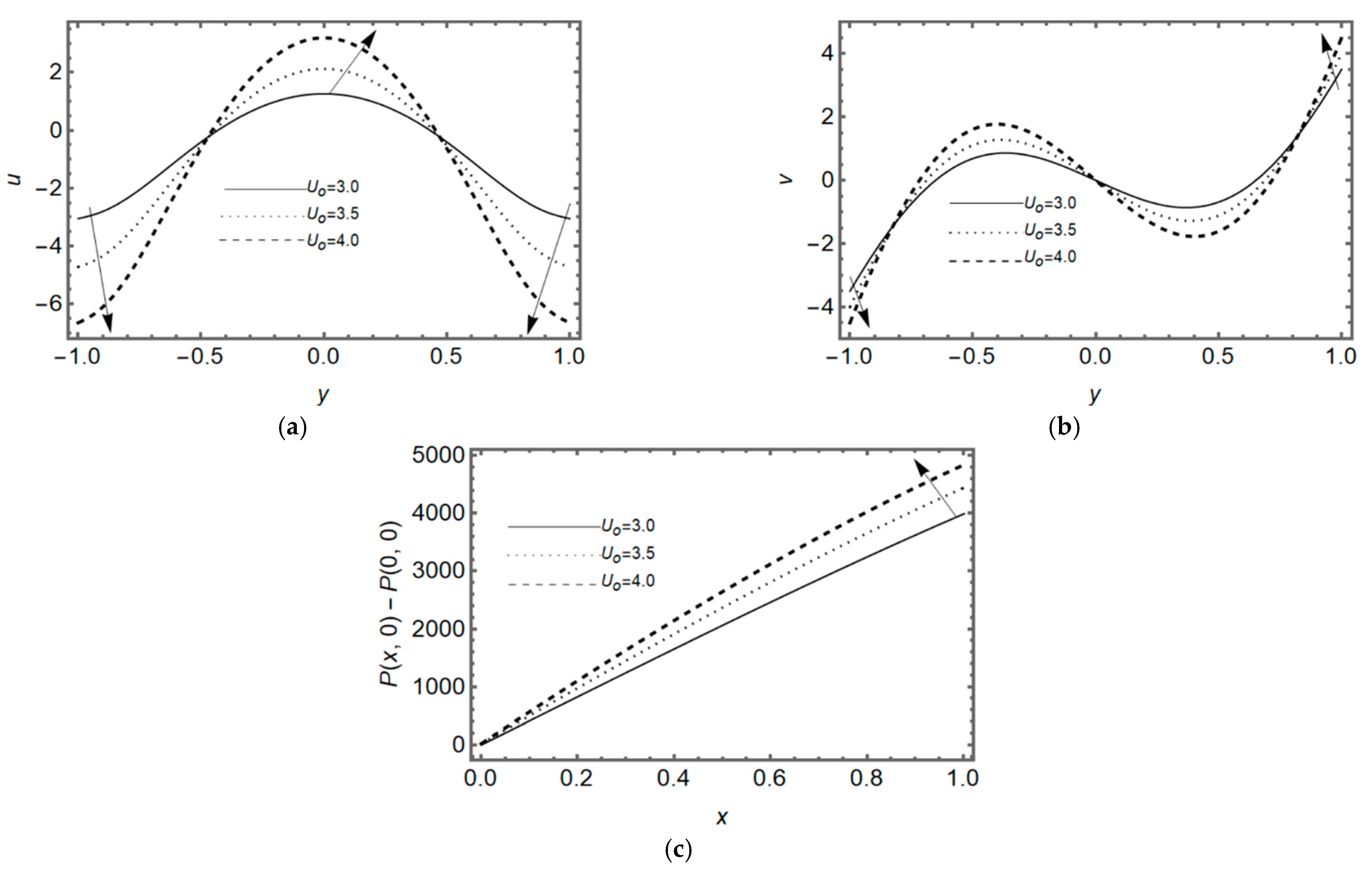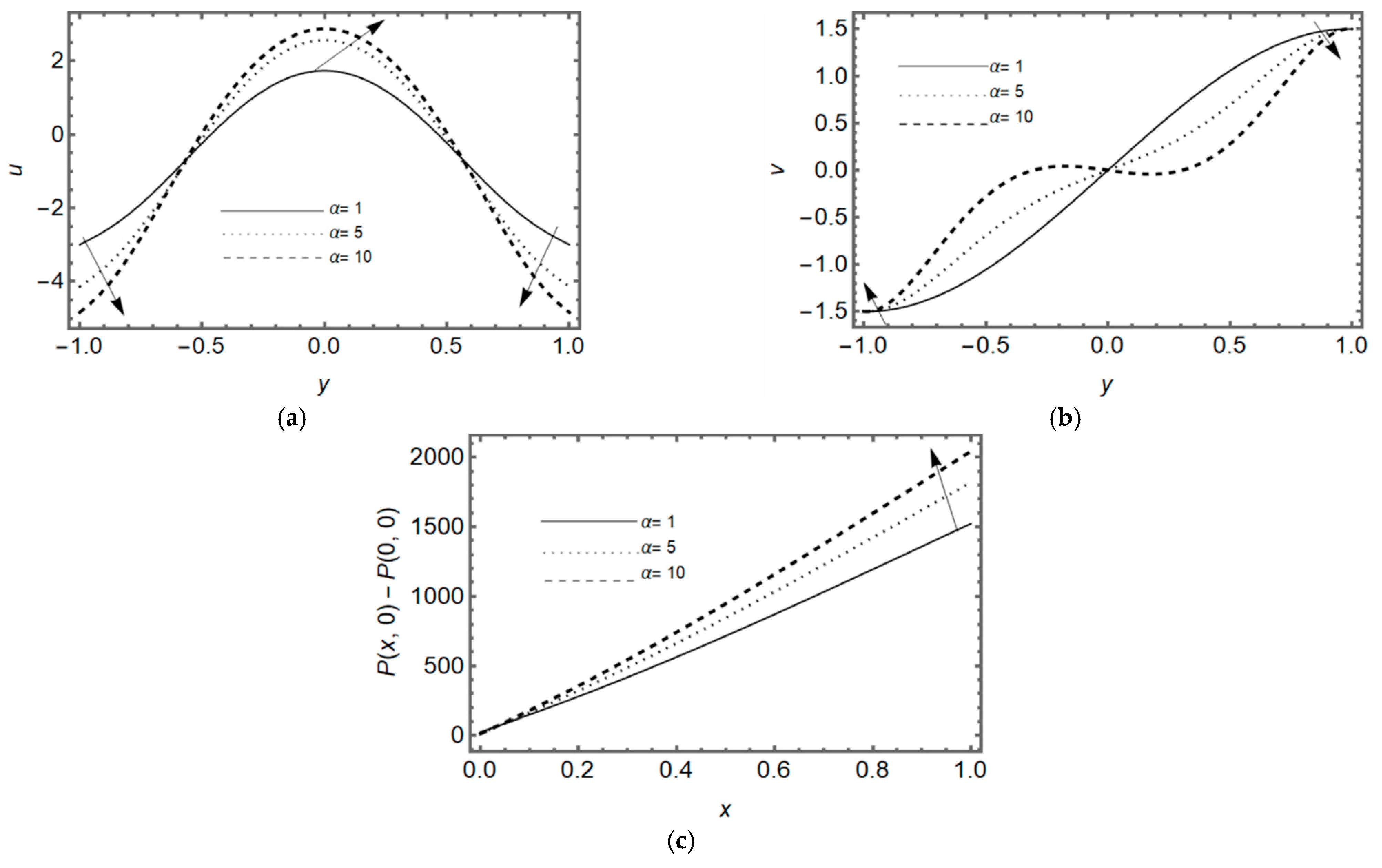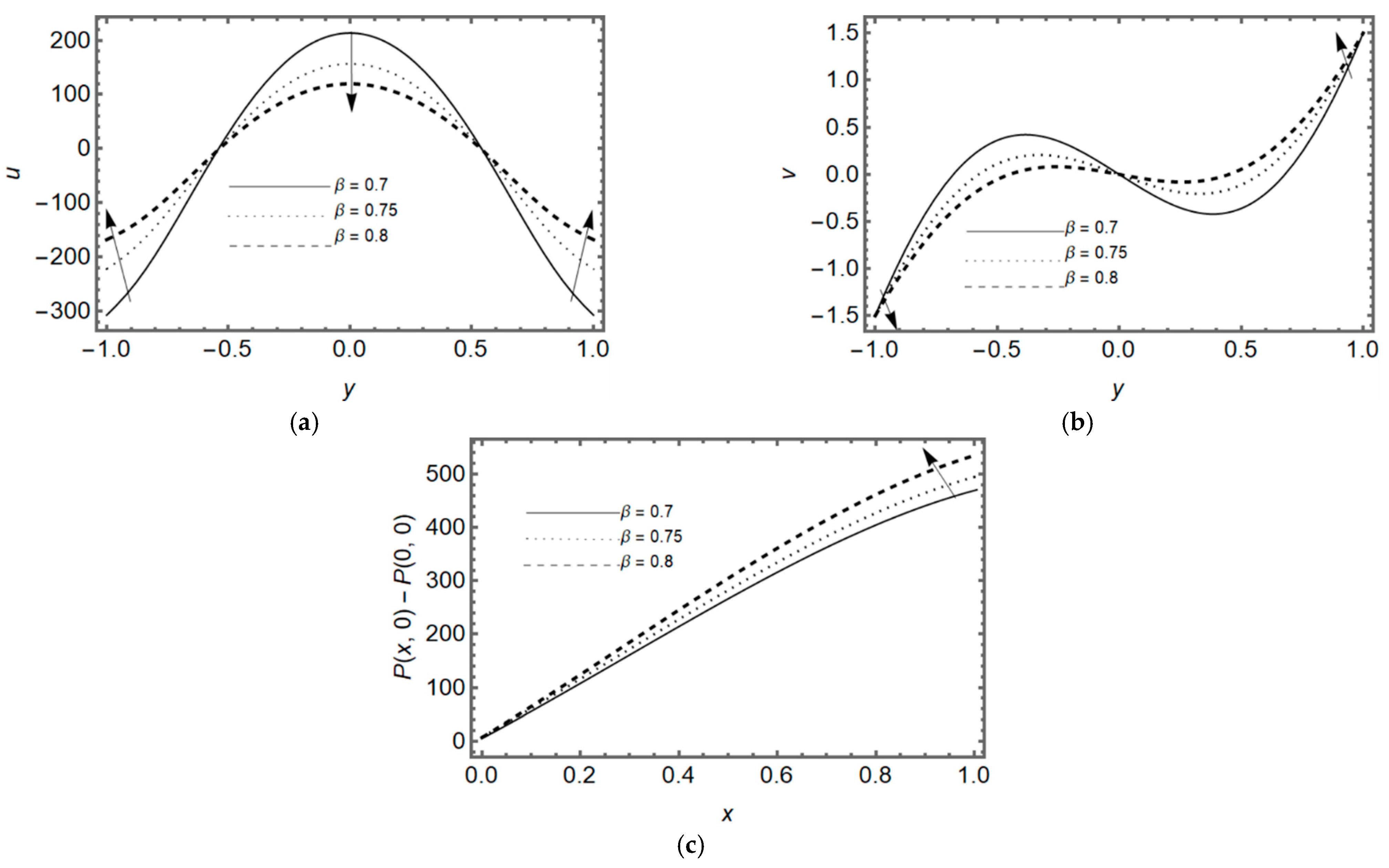Inertial and Linear Re-Absorption Effects on a Synovial Fluid Flow Through a Lubricated Knee Joint
Abstract
:1. Introduction
2. Materials and Methods
2.1. Non-Dimensional Quantities
2.2. Solution Methodology
2.2.1. First Order System and Its Solution
2.2.2. The Second-Order System and Its Solution
2.2.3. Third Order System and Its Solution
2.2.4. Special Cases
- (a)
- The present study reduces the inertial flow of Newtonian fluid when, , which has been discussed by Panek et al. [27].
- (b)
- When and the present model reduces the creeping flow of Newtonian fluid through a permeable channel with linear re-absorption that has been discussed by Haroon et al. [28].
- (c)
- The creeping flow of a couple stress fluid flow with constant re-absorption at the wall of the channel has been recently presented by Siddiqui et al. [29], which can be deduced from the present study when, and .
3. Discussion on Graphical Results
3.1. Effect of Reynold’s Number
3.2. Effect of Re-Absorption Velocity
3.3. Effect of Couple-Stress Parameter
3.4. Effect of Slip Parameter
4. Concluding Remarks
Author Contributions
Funding
Data Availability Statement
Conflicts of Interest
Appendix A
References
- Yin, W.; Frame, M.D. Biofluid Mechanics: An Introduction to Fluid Mechanics, Macrocirculation, and Microcirculation; Academic Press: Cambridge, MA, USA, 2011. [Google Scholar]
- Lai, W.M.; Kuei, S.C.; Mow, V.C. Rheological equations for synovial fluids. J. Biomech. Eng. 1978, 100, 169–186. [Google Scholar] [CrossRef]
- Ouerfelli, N.; Vrinceanu, N.; Mliki, E.; Amin, K.A.; Snoussi, L.; Coman, D.; Mrabet, D. Rheological behavior of the synovial fluid: A mathematical challenge. Front. Mater. 2024, 11, 1386694. [Google Scholar] [CrossRef]
- Singh, V.; Ganapathy, H.; Thanka, J. Synovial Fluid Analysis and Biopsy in Diagnosis of Joint Diseases. J. Pharm. Res. Int. 2021, 33, 1–11. [Google Scholar] [CrossRef]
- Hasnain, S.; Abbas, I.; Al-Atawi, N.O.; Saqib, M.; Afzaal, M.F.; Mashat, D.S. Knee synovial fluid flow and heat transfer, a power law model. Sci. Rep. 2023, 13, 18184. [Google Scholar] [CrossRef]
- Maqbool, K.; Siddiqui, A.M.; Mehboob, H.; Jamil, Q. Study of non-Newtonian synovial fluid flow by a recursive approach. Phys. Fluids 2022, 34, 111903. [Google Scholar] [CrossRef]
- Maqbool, K.; Siddiqui, A.M.; Mehboob, H.; Tahir, A. Dynamics of non-Newtonian synovial fluid through permeable membrane with periodic filtration. Int. J. Mod. Phys. B 2024, 38, 2450251. [Google Scholar] [CrossRef]
- Ramanaiah, G. Squeeze films between finite plates lubricated by fluids with couple stress. Wear 1979, 54, 315–320. [Google Scholar] [CrossRef]
- Ramanaiah, G.; Sarkar, P. Slider bearings lubricated by fluids with stress. Wear 1979, 52, 27–36. [Google Scholar] [CrossRef]
- Sinha, P.; Singh, C. Couple stresses in the lubrication of rolling contact bearings considering cavitation. Wear 1981, 7, 85–98. [Google Scholar] [CrossRef]
- Hayat, T.; Sajjad, R.; Alsaedi, A.; Muhammad, T.; Ellahi, R. On squeezed flow of couple stress nanofluid between two parallel plates. Results Phys. 2017, 7, 553–561. [Google Scholar] [CrossRef]
- Bashir, S.; Sajid, M. Flow of two immiscible uniformly rotating couple stress fluid layers. Phys. Fluids 2022, 34, 062101. [Google Scholar] [CrossRef]
- Madasu, K.P.; Sarkar, P. Couple stress fluid past a sphere embedded in a porous medium. Arch. Mech. Eng. 2022, 69, 5–19. [Google Scholar] [CrossRef]
- Ahmed, S.; Bég, O.A.; Ghosh, S.K. A couple stress fluid modeling on free convection oscillatory hydromagnetic flow in an inclined rotating channel. Ain Shams Eng. J. 2014, 5, 1249–1265. [Google Scholar] [CrossRef]
- Srivastava, L.M. Flow of couple stress fluid through stenotic blood vessels. J. Biomech. 1985, 18, 479–485. [Google Scholar] [CrossRef]
- Ozan, S.C.; Labrosse, G.; Uguz, A.K. A model of synovial fluid with a hyaluronic acid source: A numerical challenge. Fluids 2021, 6, 152. [Google Scholar] [CrossRef]
- Frisbie, D.D.; Al-Sobayil, F.; Billinghurst, R.C.; Kawcak, C.E.; McIlwraith, C.W. Changes in synovial fluid and serum biomarkers with exercise and early osteoarthritis in horses. Osteoarthr. Cartil. 2008, 16, 1196–1204. [Google Scholar] [CrossRef]
- Koh, A.S. Converging Biological Effects of Physical Activity on Cardiovascular Health in Ageing. Ph.D. Thesis, University of Dundee, Dundee, Scotland, UK, June 2024. [Google Scholar]
- Hahn, A.K.; Batushansky, A.; Rawle, R.A.; Lopes, E.P.; June, R.K.; Griffin, T.M. Effects of long-term exercise and a high-fat diet on synovial fluid metabolomics and joint structural phenotypes in mice: An integrated network analysis. Osteoarthr. Cartil. 2021, 29, 1549–1563. [Google Scholar] [CrossRef]
- Raja, U.A.; Siddique, J.I.; Ahmed, A. Biomechanical response of soft tissues during passage of synovial fluid in compression. Int. J. Comput. Methods Eng. Sci. Mech. 2023, 24, 182–192. [Google Scholar] [CrossRef]
- Haward, S.J. Synovial fluid response to extensional flow: Effects of dilution and intermolecular interactions. PLoS ONE 2014, 9, e92867. [Google Scholar] [CrossRef]
- Bridges, C.; Karra, S.; Rajagopal, K.R. On modeling the response of the synovial fluid: Unsteady flow of a shear-thinning, chemically-reacting fluid mixture. Comput. Math. Appl. 2010, 60, 2333–2349. [Google Scholar] [CrossRef]
- Oates, K.M.; Krause, W.E.; Jones, R.L.; Colby, R.H. Rheopexy of synovial fluid and protein aggregation. J. R. Soc. Interface 2006, 3, 167–174. [Google Scholar] [CrossRef] [PubMed]
- Mow, V.C. The role of lubrication in biomechanical joints. J. Lubr. Technol. 1969, 91, 320–326. [Google Scholar] [CrossRef]
- Hron, J.; Málek, J.; Pustějovská, P.; Rajagopal, K.R. On the modeling of the synovial fluid. Adv. Tribol. 2010, 1, 104957. [Google Scholar] [CrossRef]
- Ruggiero, A.; Gómez, E.; D’ Amato, R. Approximate closed-form solution of the synovial fluid film force in the human ankle joint with non-Newtonian Lubricant. Tribol. Int. 2013, 57, 156–161. [Google Scholar] [CrossRef]
- Pánek, P.; Kodým, R.; Šnita, D.; Bouzek, K. Spatially two-dimensional mathematical model of the flow hydrodynamics in a spacer-filled channel–the effect of inertial forces. J. Membr. Sci. 2015, 492, 588–599. [Google Scholar] [CrossRef]
- Siddiqui, A.M.; Haroon, T.; Shahzad, A. Hydrodynamics of viscous fluid through porous slit with linear absorption. Appl. Math. Mech. 2016, 37, 361–378. [Google Scholar] [CrossRef]
- Siddiqui, A.M.; Azim, Q.A.; Gawo, G.A.; Sohail, A. Analytical approach to explore theory of creeping flow with constant absorption. Sens. Int. 2024, 5, 100250. [Google Scholar] [CrossRef]






Disclaimer/Publisher’s Note: The statements, opinions and data contained in all publications are solely those of the individual author(s) and contributor(s) and not of MDPI and/or the editor(s). MDPI and/or the editor(s) disclaim responsibility for any injury to people or property resulting from any ideas, methods, instructions or products referred to in the content. |
© 2025 by the authors. Licensee MDPI, Basel, Switzerland. This article is an open access article distributed under the terms and conditions of the Creative Commons Attribution (CC BY) license (https://creativecommons.org/licenses/by/4.0/).
Share and Cite
Siddiqui, A.M.; Maqbool, K.; Ahmed, A.; Mann, A.B. Inertial and Linear Re-Absorption Effects on a Synovial Fluid Flow Through a Lubricated Knee Joint. Lubricants 2025, 13, 196. https://doi.org/10.3390/lubricants13050196
Siddiqui AM, Maqbool K, Ahmed A, Mann AB. Inertial and Linear Re-Absorption Effects on a Synovial Fluid Flow Through a Lubricated Knee Joint. Lubricants. 2025; 13(5):196. https://doi.org/10.3390/lubricants13050196
Chicago/Turabian StyleSiddiqui, Abdul Majeed, Khadija Maqbool, Afifa Ahmed, and Amer Bilal Mann. 2025. "Inertial and Linear Re-Absorption Effects on a Synovial Fluid Flow Through a Lubricated Knee Joint" Lubricants 13, no. 5: 196. https://doi.org/10.3390/lubricants13050196
APA StyleSiddiqui, A. M., Maqbool, K., Ahmed, A., & Mann, A. B. (2025). Inertial and Linear Re-Absorption Effects on a Synovial Fluid Flow Through a Lubricated Knee Joint. Lubricants, 13(5), 196. https://doi.org/10.3390/lubricants13050196





